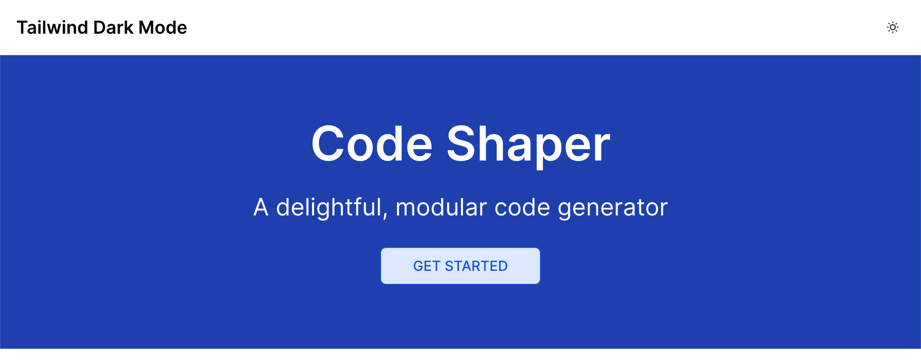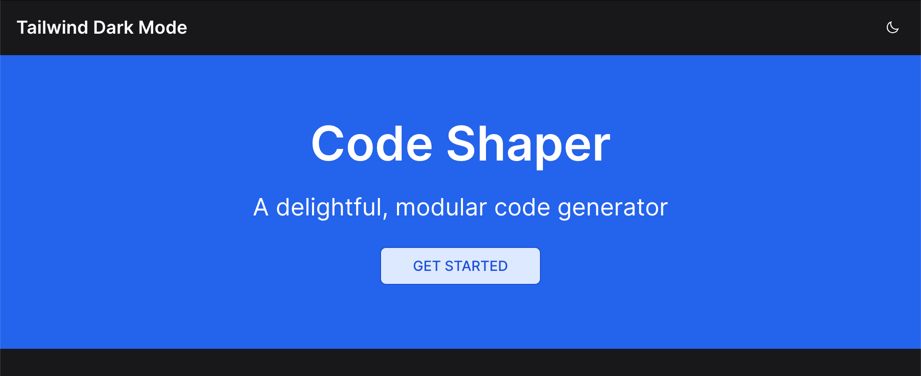Tailwind Dark Mode using semantic colors
Demo of implementing dark mode using Tailwind CSS. This version uses semantic
color tokens instead of the dark variant provided by tailwind.
Context
This approach was outlined by the Figma team in their Config 2022 presentation
titled
The hardest part about building dark mode is that people think it’s easy.
The basic concept is to use a single semantic token to represent a color instead
two atomic tokens, one for light mode and another for dark mode. For example, a
single semantic token called bg-brand instead of two atomic tokens
bg-blue-800 & dark:bg-blue-600. The advantage of such a system is that it
can scale to large teams by reducing the chance of picking inconsistent colors.
Here's an example of how I have been able to simplify my Hero banner which should show a different shade of blue in light vs. dark mode:
<!-- Before --->
<div className="bg-primary-800 dark:bg-primary-600 text-white flex flex-col items-center py-16">
...
</div>
<!-- After --->
<div className="bg-brand text-onbrand flex flex-col items-center py-16">
...
</divImplementation Approach
The implementation approach is based on a
suggestion from Adam Wathan.
Basically I define a bunch of semantic colors in tailwind.config.js using CSS
variables, e.g.
module.exports = {
theme: {
colors: {},
backgroundColor: {
default: 'var(--color-bg-default)',
'default-hover': 'var(--color-bg-default-hover)',
brand: 'var(--color-bg-brand)',
'brand-hover': 'var(--color-bg-brand-hover)',
secondary: 'var(--color-bg-secondary)',
'secondary-hover': 'var(--color-bg-secondary-hover)',
},
ringColor: {
brand: 'var(--color-ring-brand)',
secondary: 'var(--color-ring-secondary)',
},
textColor: {
default: 'var(--color-text-default)',
onbrand: 'var(--color-text-onbrand)',
onsecondary: 'var(--color-text-onsecondary)',
},
stroke: {
default: 'var(--color-stroke-default)',
},
},
};Then I define these CSS variables in global.css, once for each theme:
@layer base {
.theme-light {
--color-bg-default: rgba(var(--color-white));
--color-bg-default-hover: rgba(var(--color-neutral-900), 0.05);
--color-bg-brand: rgba(var(--color-primary-800));
--color-bg-brand-hover: rgba(var(--color-primary-700));
--color-bg-secondary: rgba(var(--color-primary-100));
--color-bg-secondary-hover: rgba(var(--color-primary-200));
--color-ring-brand: rgba(var(--color-primary-500));
--color-ring-secondary: rgba(var(--color-primary-500));
--color-stroke-default: rgba(var(--color-neutral-900));
--color-text-default: rgba(var(--color-black));
--color-text-onbrand: rgba(var(--color-white));
--color-text-onsecondary: rgba(var(--color-primary-700));
}
.theme-dark {
--color-bg-default: rgba(var(--color-neutral-900));
--color-bg-default-hover: rgba(var(--color-white), 0.05);
--color-bg-brand: rgba(var(--color-primary-600));
--color-bg-brand-hover: rgba(var(--color-primary-700));
--color-bg-secondary: rgba(var(--color-primary-100));
--color-bg-secondary-hover: rgba(var(--color-primary-200));
--color-ring-brand: rgba(var(--color-primary-500));
--color-ring-secondary: rgba(var(--color-primary-500));
--color-stroke-default: rgba(var(--color-white));
--color-text-default: rgba(var(--color-white));
--color-text-onbrand: rgba(var(--color-white));
--color-text-onsecondary: rgba(var(--color-primary-700));
}
}Now switching between the two themes is just a matter of switching the theme
class on the <html> element. This is done in the ModeToggle component.
Development Build
# Run ci in the root directory to install dependencies
npm ci
# Run the app
npm run devNow point your browser to http://localhost:3000
Production Build
npm run build
npm start
